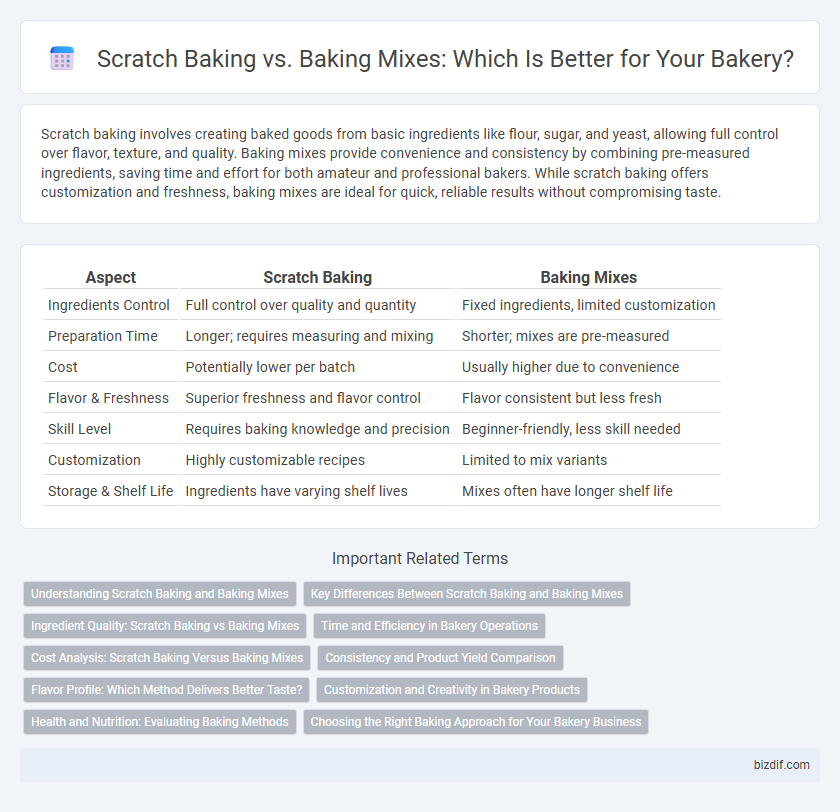Scratch baking involves creating baked goods from basic ingredients like flour, sugar, and yeast, allowing full control over flavor, texture, and quality. Baking mixes provide convenience and consistency by combining pre-measured ingredients, saving time and effort for both amateur and professional bakers. While scratch baking offers customization and freshness, baking mixes are ideal for quick, reliable results without compromising taste.
Table of Comparison
| Aspect | Scratch Baking | Baking Mixes |
|---|---|---|
| Ingredients Control | Full control over quality and quantity | Fixed ingredients, limited customization |
| Preparation Time | Longer; requires measuring and mixing | Shorter; mixes are pre-measured |
| Cost | Potentially lower per batch | Usually higher due to convenience |
| Flavor & Freshness | Superior freshness and flavor control | Flavor consistent but less fresh |
| Skill Level | Requires baking knowledge and precision | Beginner-friendly, less skill needed |
| Customization | Highly customizable recipes | Limited to mix variants |
| Storage & Shelf Life | Ingredients have varying shelf lives | Mixes often have longer shelf life |
Understanding Scratch Baking and Baking Mixes
Scratch baking involves using raw, basic ingredients like flour, sugar, eggs, and butter, allowing bakers full control over flavors, textures, and ingredient quality. Baking mixes provide pre-measured blends of dry ingredients that simplify the baking process, saving time and reducing the risk of errors for consistent results. Understanding the differences between scratch baking and baking mixes is essential for choosing the right method based on skill level, desired customization, and convenience.
Key Differences Between Scratch Baking and Baking Mixes
Scratch baking involves creating baked goods from basic ingredients like flour, sugar, eggs, and butter, allowing full control over flavor, texture, and ingredient quality. Baking mixes combine pre-measured components to simplify preparation and reduce baking time but may include preservatives and less customizable flavors. The key differences center on ingredient control, preparation time, and the ability to tailor recipes to dietary preferences or specific taste profiles.
Ingredient Quality: Scratch Baking vs Baking Mixes
Scratch baking guarantees the use of fresh, high-quality ingredients tailored to each recipe, often resulting in superior flavor and texture. Baking mixes rely on pre-measured, processed components that may contain preservatives, artificial flavors, and lower-grade ingredients to extend shelf life. Choosing scratch baking allows greater control over ingredient origin, freshness, and overall product quality compared to standardized baking mixes.
Time and Efficiency in Bakery Operations
Scratch baking demands more time and skilled labor due to ingredient measuring, mixing, and proofing, impacting bakery efficiency. Baking mixes streamline operations by reducing preparation time and ensuring consistent results with less effort. Optimizing bakery workflows often involves balancing the artisanal quality of scratch baking with the time-saving benefits of baking mixes.
Cost Analysis: Scratch Baking Versus Baking Mixes
Scratch baking often incurs higher ingredient costs due to purchasing raw materials like flour, sugar, and yeast in bulk, but it offers flexibility to control quality and portion sizes. Baking mixes provide cost savings through pre-measured ingredients and reduced preparation time, which can lower labor expenses and minimize waste. Evaluating the total cost involves balancing raw ingredient prices, labor input, and consistency needs in bakery operations.
Consistency and Product Yield Comparison
Scratch baking offers greater control over ingredient quality and recipe adjustments but can lead to variability in product consistency due to manual measurement and mixing. Baking mixes provide standardized formulations that ensure uniformity in texture, flavor, and appearance across batches, enhancing consistency. Product yield from baking mixes is typically more predictable and efficient, while scratch baking may result in fluctuating yields dependent on baker skill and ingredient variations.
Flavor Profile: Which Method Delivers Better Taste?
Scratch baking, which involves using fresh, quality ingredients like real butter, fresh eggs, and pure vanilla, typically delivers a richer and more complex flavor profile compared to baking mixes. Baking mixes often contain preservatives, artificial flavors, and stabilizers that can result in a more uniform but less nuanced taste. The direct control over ingredient quality and proportions in scratch baking allows for enhanced depth and customization in flavor, appealing to discerning palates.
Customization and Creativity in Bakery Products
Scratch baking allows bakers to customize ingredients and flavors from basic components, enabling unique texture and taste profiles tailored to specific preferences or dietary needs. Baking mixes provide convenience with pre-measured ingredients but limit ingredient substitutions and creative modifications, restricting product uniqueness. Emphasizing scratch baking enhances artisanal quality and innovation in bakery products, supporting a broader range of customized offerings.
Health and Nutrition: Evaluating Baking Methods
Scratch baking uses fresh, whole ingredients, allowing precise control over sugar, fat, and additives, which often results in healthier, nutrient-dense baked goods. Baking mixes typically contain preservatives, artificial flavors, and higher sodium levels, potentially compromising nutritional quality. Choosing scratch baking supports tailored recipes to meet specific dietary needs, promoting better health outcomes.
Choosing the Right Baking Approach for Your Bakery Business
Scratch baking offers full control over ingredients, flavor profiles, and product originality, appealing to customers seeking artisanal quality. Baking mixes provide consistency, faster production, and reduced labor costs, ideal for high-volume bakeries focused on efficiency. Selecting the right approach depends on balancing product differentiation, operational capacity, and target market preferences to optimize bakery business success.
Scratch baking vs Baking mixes Infographic

 bizdif.com
bizdif.com